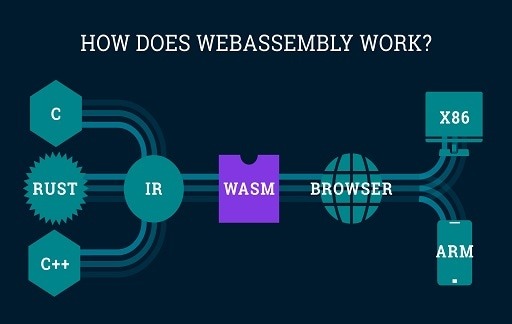JavaScript was the only language that could be used to write code that could be executed in browsers for more than twenty years. Other programming languages, such as Python, C++, and Go, were utilized primarily to develop the server components of online applications and services.
JavaScript performed admirably, but there are numerous other programming languages that are significantly more efficient. Web apps have the potential to take advantage of a wide variety of benefits by directly executing code written in other, more efficient programming languages within the browser.
As a component of the open web platform, WebAssembly provides a solution that is all at once effective, accessible, and secure. You can construct apps using it that are capable of running on browsers, servers, and in a variety of other settings.

What is WebAssembly?
WebAssembly (WASM) is a language that has been standardized by the W3C. It is efficient, low-level, and portable. It does this by defining a coding format and APIs that allow programs to communicate with web-based platforms.
The majority of programming languages can be compiled into the binary code format used by WebAssembly. The generated WASM code is interpreted and executed by browsers in exactly the same way that conventional JavaScript code is.
You may also execute WebAssembly alongside JavaScript code to improve the performance of your app and increase compatibility between the two languages.
In 2019, WebAssembly was approved as a standard by the W3C and gained support from a wide variety of programming languages.
According to Made with WebAssembly, there are already a great number of well-known projects that make use of WebAssembly in order to provide their users with software that is both quick and secure.
WebAssembly is supported by a wide variety of programming languages, including ones that are designed specifically for use on the server. Rust, Go, Python, C++, TypeScript, Java, PHP, and Ruby are some examples of these languages.
Check out the awesome-wasm-langs resource to learn about the languages that are supported by WebAssembly as well as the packages that may be used in conjunction with each of those languages.
An example of a WebAssembly program that can return a maximum of two integers is provided below from Tutorials Point:
In comparison to JavaScript, the syntax for WebAssembly is somewhat lengthy; nonetheless, this should not be a barrier for developers. Because WebAssembly will serve as the compilation target for the programs you create in the language of your choice, there will be no need for you to understand the syntax.
How does WebAssembly work?
WASM is a target that other programming languages can compile into because it is available as a compilation target. You are free to write in whichever programming language you choose, and the resulting source code can then be compiled into WASM bytecode for execution on the client.
It is possible for it to run at a high speed after being translated into native machine code, often quicker than JavaScript.
Interoperability with JavaScript is regarded as one of the most important aspects of WASM. It is possible to import WASM modules into a web application and then expose the WASM functions so that JavaScript code can make use of them. WASM can be leveraged by JavaScript frameworks to increase their overall performance.
A sandboxed execution model, comparable to JavaScript’s, is utilized by WASM. ABIs, or Application Binary Interfaces, are the means through which WASM communicates with the host machine.
One example of an ABI is the WebAssembly System Interface, which grants access to various resources and other system services according to the needs of the program.
WASM is supported by a wide variety of contemporary browsers, including Chrome, Microsoft Edge, Mozilla Firefox, Opera, and Safari. The WASM assembly language is natively supported by languages such as Go and Rust.
Why WebAssembly is necessary for the Web
By its very nature, JavaScript has a restricted set of capabilities. Since it was originally developed as a scripting language for the web, it is not considered to be one of the languages with the highest speed or performance.
Even though there are multiple runtimes where JavaScript can run at different speeds, WebAssembly can bring faster and more performant languages to the web for use cases like games, videos, and music. These use cases include things like streaming music and videos.
Additionally, WebAssembly extends greater portability and flexibility to programming languages that aren’t designed to operate on the web. It is expected that adding more languages to the web, which is currently the most popular open-source platform, will result in an overall improvement in the user experience.
Adoption of WebAssembly is proceeding at a Breakneck Pace
WebAssembly is being used to construct applications by a large number of businesses and developers. Some of the applications developed by Google, Dropbox, and Cloudflare all make active use of the WebAssembly programming language.
WebAssembly is widely used by programmers that work with Python, C++, and Rust. Pyoidide and PyScript are popular choices for Python programmers, whereas Emscripten is a popular choice for C++ programmers. Rust programmers typically utilize Percy, Yew, Sycamore, MoonZoon, and the Seed framework.
Would you like to read more about WebAssembly-related articles? If so, we invite you to take a look at our other tech topics before you leave!









